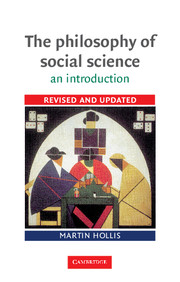Book contents
- Frontmatter
- 1 Introduction: problems of structure and action
- 2 Discovering truth: the rationalist way
- 3 Positive science: the empiricist way
- 4 Ants, spiders and bees: a third way?
- 5 Systems and functions
- 6 Games with rational agents
- 7 Understanding social action
- 8 Self and roles
- 9 Explaining and understanding
- 10 A value-neutral social science?
- 11 Rationality and relativism
- 12 Conclusion: two stories to tell
- Bibliography
- Index
7 - Understanding social action
Published online by Cambridge University Press: 03 July 2012
- Frontmatter
- 1 Introduction: problems of structure and action
- 2 Discovering truth: the rationalist way
- 3 Positive science: the empiricist way
- 4 Ants, spiders and bees: a third way?
- 5 Systems and functions
- 6 Games with rational agents
- 7 Understanding social action
- 8 Self and roles
- 9 Explaining and understanding
- 10 A value-neutral social science?
- 11 Rationality and relativism
- 12 Conclusion: two stories to tell
- Bibliography
- Index
Summary
In trying to focus the problem of structure and action on M. Rouget's vote, we might have hoped that there is an agreed method of explanation in the natural sciences which could be imported into the social sciences. But there is not; and that is partly, no doubt, why it is hard to decide whether the holistic approaches deployed in Chapter 5 are undercut by the Rational Choice version of individualism proposed in Chapter 6. On the other hand, there have been signs that the social sciences may call for a scientific method of their own. The next two chapters will examine some ideas about the understanding of social action which suggest that the social world can only be tackled from within and by methods different from those suited to the natural sciences.
To clear the deck, let us start with a brisk reminder. M. Rouget took the stage in Chapter 3 as a case study in Positive science and the application of a universal scientific method to social phenomena. To explain his voting communist was to cite statistics from which his vote could have been predicted with high probability. The epistemic warrant was a principle of induction, and the scientific method was one for confirming or refuting inductive generalisations, as in Iipsey's 'percolator'. This approach to explanation has fared badly even for the natural world.
- Type
- Chapter
- Information
- The Philosophy of Social ScienceAn Introduction, pp. 142 - 162Publisher: Cambridge University PressPrint publication year: 1994



